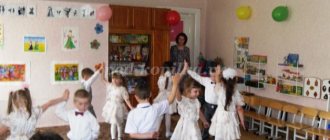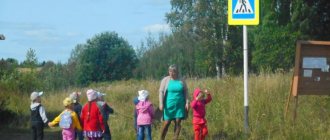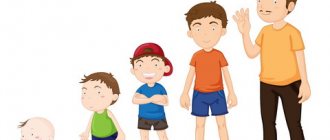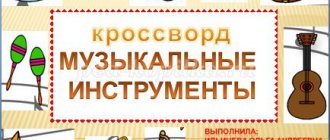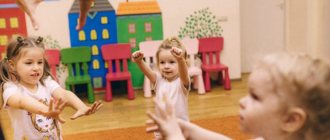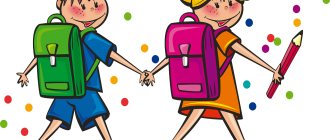Methodological development “Musical and rhythmic movements in kindergarten”
Irina Chichina
Methodological development “Musical and rhythmic movements in kindergarten”
Musical and rhythmic movements in kindergarten
“Perhaps the best, most perfect and joyful,
What life has is free movement to music .
And you can learn this from a child and with him.”
Anna Iosifovna Burenina
Music is the most emotional art (D. B. Kabalevsky)
.
Its impact on the formation of personality is enormous. “ It’s hard to imagine a person’s life music Without the sounds of music, it would be incomplete, deaf, poor... Music lovers and connoisseurs are not born , but become.” These words of the greatest composer of our time, D. Shostakovich, most fully reflect the basic view of the musical ear for music at all .” A fairly common formula for determining the reason for the lack of abilities of a son or daughter. However, everything in reality is somewhat different. Teachers and musicians have come to the conclusion that everyone has the inclinations for musical activity , i.e., the physiological abilities of the body, for example, the organ of hearing or the vocal apparatus. It is this that forms the basis for the development of musical abilities . And therefore it is considered proven that if the necessary conditions are created for musical development, then this has a significant effect in the formation of his musicality .
What is musicality ? This is a set of abilities that allow a person to actively express himself in various types of musical activities : listening, singing, movement .
Musical-rhythmic movements are a synthetic type of activity - this is one of the types in which the content of music , its character, and images are conveyed in movements . Therefore, any movements to music develop an ear for music , motor abilities, and the mental processes that underlie them and contribute to the emotional and psychophysical development of children.
Movements to music have been used in raising children since ancient times (Ancient India, China, Greece)
.
the Swiss teacher and composer Emile Jacques Dalcroze who first considered rhythm and substantiated it as a method of musical Before rhythmics, he first of all set the task of developing musical abilities , as well as plasticity and expressiveness of movements . The special value and viability of his system of musical and rhythmic education lies in its humane nature. E. Jacques-Dalcroze was convinced that it was necessary to teach rhythm to all children. He developed in them a deep “feeling”
, penetration into
music , creative imagination, formed the ability to express themselves in movements , and at the same time believed that music is the fundamental principle. The synthesis of music and movements concretizes the game image. On the one hand, the musical image contributes to a more accurate and emotional execution of movements , on the other hand, the movements explain music , the main means of expression. Such complex phenomena as meter rhythm, register, musical form , which are difficult to explain to children in words, are perceived by preschoolers not only with the ear, but with the whole body, this increases the musical experience , making it more conscious.
Movement exercises are of invaluable importance, especially for somatically weakened children, children with an unstable nervous system, immaturity of the emotional-volitional sphere. After all, motor exercises primarily train the brain and the mobility of nervous processes . Therefore, it is so important to introduce clumsy, motor-inhibited children to movement to music , who need to be helped to gain feelings of self-confidence or, conversely, disinhibited and hyperactive children, in order to teach them to control their emotions and feelings. In the process of mastering movements to music children learn to focus on music as a special signal for action and movement , they improve motor skills, coordination of movements , develop voluntary movements , non-verbal communication abilities, and form and develop ideas about the connection between music and movements .
Scientific research has proven that any sound causes muscle contractions in humans. The whole body responds to the action of music . The perception and understanding of music lies in the sensation of it through the ligaments, muscles, movement , and breathing. Musicologist professor L. Medushevsky wrote: “The infinitely rich information contained in music is read not by the mind, but by the dynamic state of the body - co-intonation, pantomimic movement .” It is known that movement influences the nature of perception of music .
B. M. Teplov also proved the fact that the perception of music by motor reactions (vocalizations, small finger movements, etc. )
.
Also, well-known domestic and foreign teachers and psychologists studied the problem of musical-rhythmic education. Among them: D. B. Kabalevsky, B. M. Teplov, E. A. Flerina, M. A. Rumer, T. S. Babajan, N. A. Metlov, Yu. A. Dvoskina, A. V. Keneman, S. D. Rudneva, N. A. Vetlugina, O. P. Radynova, A. I. Burenina and many others.
Introducing children to music comes in different ways. In the field of musical and rhythmic activity, it occurs through accessible and interesting proposals - exercises, musical games , dances, round dances, which help the child to better feel and love music , get into its mood, realize the nature of the work, understand the form, expressive means.
Musical and rhythmic activities are aimed at developing aesthetic, physical, moral and mental qualities in each child.
In the field of musical-rhythmic movements, the following tasks are solved:
1. Enrich children's musical experiences and create a joyful mood.
2. Develop rhythmic movements to music .
3. Lead to expressive execution of movements , to joint and individual actions.
, musical and rhythmic skills are developed :
• Start movements independently after entry ;
• Independently change movements depending on the form (2 and 3-part, dynamics (loud - quiet, register (high - low)
;
• Perform movements , in general, for all tempos, coordinate them;
• Move at a moderate, fast pace.
When learning musical and rhythmic tasks, the teacher uses various methodological techniques , taking into account the age characteristics of the children.
One of the most important teaching techniques is a holistic visual and auditory demonstration. Music and movements are one . Teacher alone (or with a child)
can show
a movement being learned to musical accompaniment . Correct demonstration of movements and precise instructions help the child perform a particular movement .
Thus, the perception of music is an active auditory-motor process. Through movement music more vividly and emotionally , feels the change in its mood, consolidates knowledge about the means of musical expression , understands and feels it, develops emotions, interests, tastes, i.e., becomes familiar with musical culture , and his spiritual world is enriched.
It's no secret that people love to move to music , but spontaneous dance is not a product of human intellectual activity, it is rather a movement that occurs at the subconscious level. It is much more difficult to accurately perform a set of movements in a certain sequence to certain music . It is even more difficult to dance in a group when it is necessary not only to perform a movement , but also to perform them synchronously. When learning a dance, many of the child’s skills are trained: memorization of individual movements and movements in a complex , coordination of movements , the ability to listen to music movements to it (i.e., a sense of rhythm, the ability to express themselves creatively. All these skills help to form the child’s mental abilities, i.e. e. help develop intelligence.
Music , movement and the development of intelligence are closely related. The emotional impact of music is deeply comprehended by the child and acquires a personal impact. Raising a smart child is difficult, but raising a sensitive person is even more difficult.
Musical-rhythmic movement , or in other words, dance, is a form of learning that is comfortable, interesting, and gives the opportunity for self-expression.
Developing a child harmoniously, solving these and other tasks, it is necessary to understand exactly what we want from this particular child now and in the expected future. It is at preschool age that children do not experience the feeling of inconvenience or embarrassment associated with the fact that something may not work out. Freedom of movement is lightness and joy. I really like the motto of G. P. Fedorova: “Dancing is developing the mind”
. It is in preschool age that the foundations of harmonious mental, moral, and physical development are laid, and the child’s personality is formed.
Mastering dance compositions, children memorize certain combinations of alternating movements , while striving to interact with each other, navigate in space, and improvise.
Children have their own perception of what happens in class - they are all unpredictable, and, oddly enough, children are interested in more complex compositions, and they perform them with greater emotional impact.
Emotionality is achieved not only by musical accompaniment , but also by figurative exercises and complex compositions that meet the age characteristics of preschoolers who are prone to imitation and copying adults.
Experts call children of preschool age labor geniuses and great creators. The child creates not only drawings or plasticine figures, not only dance compositions and simple songs - the child creates himself, improves memory and attention, character and will.
The value of children's creativity is not in the result, but in the process; it is needed not by the audience, but by the children.
Much is changing in our lives, but I want to believe that one of the principles of humanistic pedagogy: “Where there is benefit for children, there should also be pleasure for them M. Montel” will help solve the tasks assigned to us, teachers and parents, to help preschool children age in the aesthetic game to enter the world of music , feel and experience it sensually, create the prerequisites for the formation of creative thinking, and promote the practical assimilation of musical knowledge .
A child should not be afraid to make mistakes. That's why he's a child, so he can't do much. That's why we are adults, to teach. We need to look for ways to each other, ways of understanding, then the process of learning and education will bring joy to both adults and children.
Ps: In kindergarten, instead of the term “rhythmic movements ,” “ musical-motor education ,” then “ movement to music ,” “ musical movement ,” “ musical-rhythmic movements ,” “ musical-rhythmic activity .” There has been debate over the years about the most precise formulation. However, there is no fundamental difference between all these terms, since most specialists in musical and rhythmic education in preschool institutions rightly considered music the “starting point” in rhythm, and movement as a means of its assimilation.
Musical-rhythmic movements as a means of developing a sense of rhythm in children with special needs development
Author:
Krasovskaya Olga Vladimirovna,
musical director
MBDOU kindergarten k/v No. 56 “Iskorka”,
city of Surgut
Many teacher-researchers have written about the influence of music on children, about its importance in aesthetic, mental, and moral education, emphasizing the need to cultivate general musicality from early childhood. B. M. Teplov identified three main musical abilities: modal feeling, voluntary use of auditory ideas, rhythmic feeling.
Rhythmic ability occupies a special place among abilities. Research by scientists who studied children with speech problems (L. A. Wenger, G. A. Volkova, V. A. Griner, etc.) drew attention to the fact that preschool children with speech disorders had an insufficient development of the sense of rhythm, As a result, violations of the syllabic structure of words and irregular speech were noted. In this regard, the problem of developing rhythmic foundations in this category of preschoolers has always remained relevant.
The sense of rhythm is one of the main musical abilities. It has not only a motor, motor, but also an emotional nature. Rhythm helps to combine words, music and movement in special complex exercises. The development of motor skills and expressive speech in a child occurs in close unity. This means that under the influence of correctional work they can improve simultaneously. Music, being an organizing factor, regulates movement and speech. The development of a rhythmic sense is based on the perception of the expressiveness of music through movements. Well developed, it allows the child to understand and experience music, gives the opportunity to live in it, feel, and move. Rhythm shapes the body and spirit of a child, helps him realize his strengths and find the joy of life through creativity. At the same time, rhythm is also the basis for the correct formation of speech and its perception. Much attention in special pedagogy is paid to the use of music in correctional and developmental work with children with general speech underdevelopment (GSD). Currently, in special preschool groups for children with special needs, work on the development of musical and rhythmic abilities, correction of motor disorders, formation of the rhythm of movements and speech is carried out in various organizational forms: in speech therapy, logorhythmic, physical education classes, as well as in groups and in free leisure activities. At the same time, methodological approaches to the formation of rhythmic abilities in children are not clearly defined. In this regard, the urgent problem is studying the development of musical and rhythmic abilities in children with special needs, developing a system for developing a musical and rhythmic sense, motor sphere and rhythmic structure of speech in this category of pupils.
Based on many years of experience working with children with speech disorders, I dare to say that their developmental problems can be successfully solved in music and music-rhythmic classes. After all, the universal nature of the sense of rhythm in the interaction of music, movement and speech ensures the development of musical and rhythmic abilities, increases the effectiveness of correctional speech therapy
impact. However, music directors often simply copy the work of a speech therapist, including a large number of speech therapy tasks, or simply ignore the specifics of the work of correctional groups. Without taking into account the characteristic features of the development of children with speech pathology, without taking into account the correctional tasks set, they conduct classes and morning performances in the same way as in general education groups. Not paying attention to how important it is for children with special needs to work on the development of musical and rhythmic abilities, teachers simply replace it with other types of activities. But with a competent approach to solving both correctional and musical-pedagogical problems, children-speech pathologists are transformed. Under the influence of music, musical exercises, games, provided that skillfully selected techniques are used, mental processes and musical abilities develop positively, and speech becomes clearer. Unfortunately, there is no relatively complete description of the musical and rhythmic abilities of preschool children with ODD; a special comprehensive methodology for the development of these abilities has been developed very vaguely. Based on personal observations, I came to the conclusion that it is most effective to develop a sense of rhythm in children with special needs through a system of musical correctional influence with the help of musical rhythmic movements, as the most natural and favorite type of activity for preschoolers.
I am sure that the earlier purposeful activities begin to develop musical and rhythmic abilities, the higher the results in the development of speech function, voluntary activity, motor skills, plasticity, expressiveness of movements, non-verbal communication, as well as in the development of other musical abilities. The rhythmic sense is most effectively developed by using a system of musical-rhythmic movements and exercises in frontal and subgroup music classes. Movements to music as a type of musical activity consist of two components:
- musical-rhythmic skills (the ability to convey through movements the means of musical expression: rhythm, tempo, dynamics, form, character of a musical work);
- skills of expressive movements (basic, gymnastic with and without objects, plot-shaped, dance).
In the process of forming movements to music in children with special needs, the following tasks are solved:
- Development of musical perception, the ability to convey various means of musical expression;
- Mastering the “language of movements”, its semiotic forms, the ability to convey a musical image with the help of gestures, facial expressions, pantomimes in dance and play;
- Development of creative manifestations in movements to music, the formation of musical-motor improvisation in plot-game compositions, etudes, plot dances;
- Implementation by means of movements of correction of the cognitive, emotional-volitional, motor, personal spheres of a child with ODD.
The solution to these problems occurs through the main types of movements to music (games, dances, dances, round dances, exercises) in which the general mobility, motor activity, natural for the child, a strong emotional response to music, the desire to move to it together with peers give positive results in development rhythmic abilities. I try to apply all of the above tasks when planning and preparing music lessons, where the priority is the development of a rhythmic sense.
A teacher working with children with special needs must also take into account the psychophysical characteristics of the pupils. They, as a rule, have a violation of mental processes and properties, manifested in insufficient development of perception, attention and memory, poor orientation in space, poor coordination of movements, disruption of the processes of excitation and inhibition, delayed inclusion in activities, and poor interest. There is insufficient development of the child’s personality (self-awareness, self-esteem, relationships with friends, motivation). Therefore, the main principle that a music director should follow is attention to each child, taking into account his age, speech, and individual characteristics.
Taking into account the above characteristics of children with ODD, a music lesson should be dynamic, intense, conducted in a playful way with a mandatory change of calm and active activities, and have a very clear structure, including the following types of activities:
1 musical and rhythmic exercises;
2 exercises that develop a sense of rhythm;
3 finger gymnastics;
4 listening to music;
5 chanting, singing
6 musical and rhythmic movements (dances, round dances, games).
I would like to dwell in more detail on the musical and rhythmic movements and exercises I use in my classes.
Exercises that develop a sense of rhythm
I took this type of activity from the “This Amazing Rhythm” method by I. Novoskoltseva and I. Kaplunova. The strength of this manual is differentiation in accordance with the age characteristics of children, for whom the perception of sound stimuli organized in time series, mastered through movement, gradually becomes more complex. This process can be accelerated with the help of games and fun. If children enjoy the musical-motor exercises proposed in the method, then the task of developing a sense of rhythm will be successfully solved.
Musical and rhythmic exercises
In speech therapy groups, great importance is given to this type of activity. Children with OHP often cannot cope with basic movements (walking, running, jumping), not to mention their varieties (directed or springy walking, wide or high running, jumping, straight and lateral gallops, etc.). It is very important, in my opinion, to teach children to listen to the musical rhythm and focus on the downbeat. The teacher must constantly remind students of this. If this is not done, children, getting carried away, forget about the rhythmic side of the melody and perform movements chaotically. Musical-rhythmic exercises provide an opportunity to develop physically, strengthen the musculoskeletal system, teach you to control your body rhythmically to music, and prepare you to perform more complex motor tasks in dancing and games.
Partner dance
Mastering dance movements contributes to the musical and rhythmic development of children with special needs, develops their ability to move easily and rhythmically to music, develops orientation in space and coordination of movements. In the practice of working with children speech pathologists, I tried to take into account the level of development of motor skills, the level of development of rhythmic abilities, the individual characteristics of children and, taking this into account, I selected musical material. Of great importance in musical correctional work is the obligatory use of paired dances and dances, since when chosen correctly, they develop attention, coordination, orientation in space, a sense of rhythm, as well as a mechanism for adjusting movements to the music and the movements of the partner. When selecting a musical repertoire, you should consider whether most children can cope with the movements. Those who cannot cope with the tasks must be dealt with individually. The music chosen for the dance should have clearly defined characteristic parts that set children up for a specific movement. It is advisable to choose pair dances with rhythmic tasks (claps, stomps, squats, jumps), as well as tasks for the development of orientation in space. Preparatory work can be of great help when learning a pair dance: the most difficult dance figures are learned with children in advance.
Dancing with singing and round dances
Dancing with singing and round dances are very useful for children with special needs, as they help them develop vocal-motor coordination and regulate the tempo and rhythm of movement. Children should perform dance and round dance movements initially with the support of a teacher, which gives the most maximum corrective effect. Round dances are usually the culminating part of the lesson. By this time, all the children are already participating in the action, even the most passive children are animated and involved in the general dance. It is at this time that the child can begin to do something that could not be done before, new sounds and words appear, and those already practiced are updated. In my opinion, a high-quality approach to the choice of musical repertoire is of great importance for the development of musical and rhythmic abilities in children with ODD. It must meet the following requirements:
- Appropriate for age.
- Be small in volume (lasting 1.5-3 minutes).
- The tempo of execution should be moderately fast or moderately slow.
- Have a clear and precise rhythmic structure.
- The musical image, character, and mood of a musical work must be understandable to children.
Music games
Play, related to musical and rhythmic movements, is the main activity of preschoolers with ODD. Musical games are of great importance in the rhythmic development of children. In them, the content and nature of the movement are determined by the music. It is known that games, giving children joy and the opportunity to express their emotions, contribute to the development of their sense of rhythm, cognitive interests, vocal-motor coordination, and dexterity.
Games accompanied by singing (round dances, dramatization of songs) are an integral component for the musical development of a child with ODD. In them, the child learns to convey the content of the song and the nature of the music with his movements. The expressive means of music, especially its rhythmic pattern, are learned easily and naturally through playful movements that imitate this or that action. Suitable repertoire for games accompanied by singing: folk songs, jokes, round dance songs. Their melodies and musical images are simple, accessible, have a bright and rhythmic visual basis, which makes it possible to accompany singing with expressive rhythmic movements in accordance with the nature of the music and musical image. Here it is very important to pay children's attention to vocal-motor coordination. At first, it is difficult for them, and working on coordinating singing and movements is a rather labor-intensive and lengthy process.
Word games have their roots in folklore. The musicality and songfulness of games with words allows them to be successfully used in music classes. They develop a sense of rhythm, allow you to consolidate complex motor skills, automate movements, improve intonation and poetic hearing, musicality, coordination of movements, expressiveness, etc. When choosing a particular game with a word for learning, the music director must be sure that the children will not cope only with text, but also with movements, they will be able to do this and will not require much time and effort to learn. Otherwise, work will turn into drill and will cause a negative attitude and negative emotions in children, and will negate the benefits of these games.
As a result of musical-rhythmic activities with children with ODD, during which the children systematically developed a musical-rhythmic sense, developed motor skills, and corrected the rhythmic aspect of speech more successfully. The relationship between speech, movement and music in children with ODD, according to my observations, follows the same patterns as in normally developing children. However, this process of development of voluntary movements occurs with general underdevelopment of speech much more slowly and at a later date.
Therefore, to summarize the above, I would like to advise music directors working with children with ODD to use musical-rhythmic movements as the leading means of developing a sense of rhythm in preschoolers with general speech underdevelopment in the system at each music lesson. As a result of the work, you will receive tangible dynamics in the development of musical and rhythmic abilities, motor skills, coordination of movements, and, as a result, the development of speech functions in preschoolers.
Literature:
Teplov B. M. Psychology of musical abilities (edited by Golubeva E. A., Guseva E. P., Koltsova V. A., etc.). M.: Nauka, 2003. – 379 p.
Wenger L. A. Genesis of sensory abilities. M.: Pedagogika, 1976. – 256 p.
Volkova G. A. Speech therapy rhythm. M.: Humanite. Ed. VLADOS Center, 2002. – 272.
Griner V. A. Speech therapy rhythm for preschoolers. M.: UchPedGiz, 1958. – 341 p.
Komissarova L.N., Medvedeva E.A., Musical education of children with developmental problems and corrective rhythm. M.: TC Sfera, 2002. – 198 p.
Kaplunova I.M., Novoskoltseva I.A. This amazing rhythm. St. Petersburg Composer. 2005. – 76 p.
Tarasova K.V. Ontogenesis of musical abilities. M. Pedagogy, 1988. 173 p.
Shcherbakova N. Musical education of children with speech disorders. //Musical director magazine. – 2005. – No. 2. – p.35 – 37.
“Certificate of publication in the media” Series A No. 0002322
Barcode (receipt number) 62502670051707 Date sent January 22, 2014
We invite teachers of preschool education in the Tyumen region, Yamal-Nenets Autonomous Okrug and Khanty-Mansi Autonomous Okrug-Yugra to publish their teaching materials: - Pedagogical experience, original programs, teaching aids, presentations for classes, electronic games; — Personally developed notes and scenarios of educational activities, projects, master classes (including videos), forms of work with families and teachers.
Why is it profitable to publish with us?
1. “Kindergartens of the Tyumen Region” is an officially registered specialized media outlet at the federal level. 2. The activities of the editorial office are supported by the Department of Education and Science of the Tyumen Region 3. We issue a “Certificate of Publication” in the media. 4. The document has a unique number, is entered in the register, has the original seal of the editorial office of the online publication and signature. 5. “Certificate of publication” in the media is sent to the author in both paper and electronic versions.
Details >>>
Sample “Certificate of publication of author’s methodological material in the media.”pdf
Share
